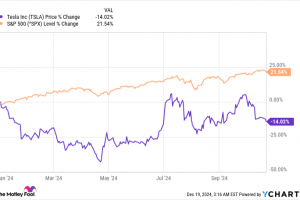
Nvidia (NASDAQ: NVDA) became one of the hottest tech stocks over the past decade as the artificial intelligence (AI) market expanded. The chipmaker, which had previously generated most of its revenue from gaming GPUs, expanded into the data center space with more powerful GPUs that made it easier to process AI tasks.
That first-mover’s advantage lit a fire under Nvidia’s business as large companies upgraded their AI capabilities. As a result, its revenue grew at an impressive compound annual growth rate (CAGR) of 31% from fiscal 2014 to fiscal 2024 (which ended this January) while its stock skyrocketed 16,570% over the past 10 years. Analysts expect its revenue to continue growing at a CAGR of 35% from fiscal 2024 to fiscal 2027.
Image source: Getty Images.
Those growth rates suggest Nvidia remains one of the easiest ways to profit from the secular expansion of the AI market. Unfortunately, not every tech company that focuses on the AI market is destined to be a long-term winner like Nvidia. So today, I’ll focus on two weaker AI stocks that could fizzle out even as the broader market expands: AI software maker C3.ai (NYSE: AI) and auto chipmaker Mobileye (NASDAQ: MBLY).
C3.ai faces existential challenges
C3.ai develops AI algorithms that can be plugged into a company’s existing software to automate, streamline, and accelerate certain tasks. That strategy sounds promising, but it faces a lot of competition and generates about 30% of its revenue from a joint venture with the energy giant Baker Hughes. That deal is set to expire in fiscal 2025 (which ends in April 2025), and there’s no guarantee it will be renewed.
C3.ai’s revenue rose just 6% in fiscal 2023, decelerating from its 38% growth in fiscal 2022 and broadly missing its original target of 22% to 25% growth. It blamed that slowdown on the macro headwinds and an abrupt shift from its stickier subscription-based plans to more flexible usage-based fees. C3.ai claims it can generate 11% to 20% revenue growth in fiscal 2024, but its habit of overpromising and underdelivering doesn’t inspire much confidence in that…
..






